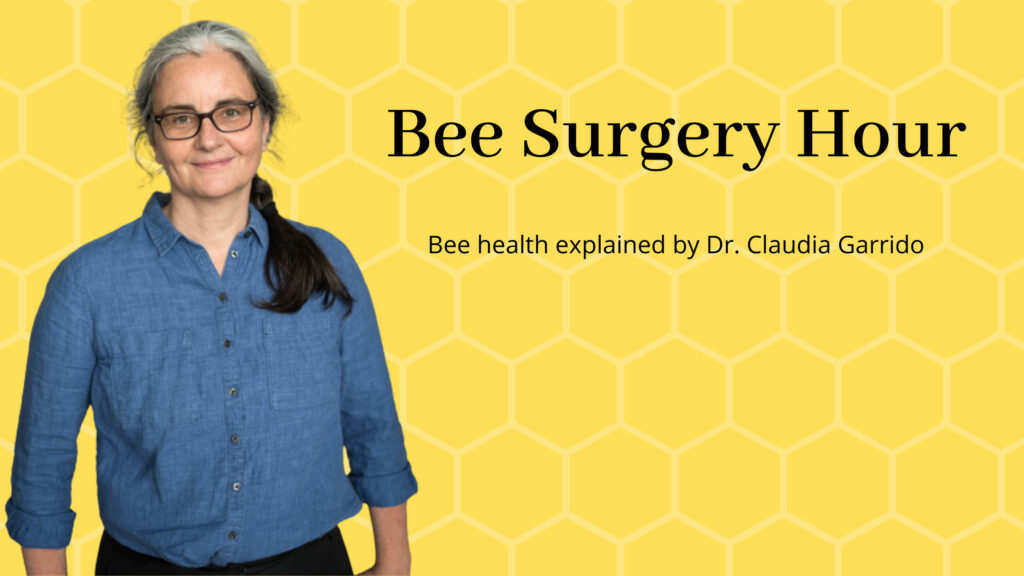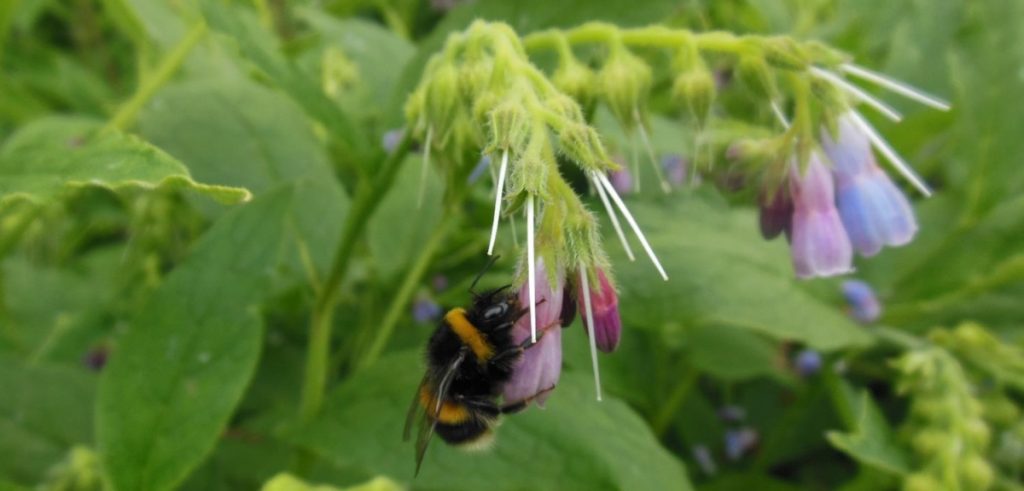One of my most requested talks currently is about the challenges for bee health that result from the climate change and the loss of biodiversity. There’s a beginning awareness, with quite a bit of insecurity what to do. Or if we’re doomed. Though on some days I would tend to the second, I’m definitely opting for the “try it anyway”. In this context, this means to analyse where we at, what we can expect, and what we can do about it.
Where we’re at
I think by now it should be clear that we’re in trouble. The past months have been full of extreme weather events: wildfires, floodings, heat waves, and rising temperatures in the ocean. This is all very concerning, at different levels. Though in the news this was discussed mainly from the human perspective, this also has immense ecological impact. I ranted a bit about the very limited perspective on LinkedIn. I’ll stay with beekeeping here, to be able to go into some detail without overwhelm.
Too hot and dry…
All of the extreme weather events we saw this summer in Europe and other places also affect beekeeping. For instance, fires can burn apiaries. This also affects science, by the way: An experimental apiary on Sicily lost three colonies to the fire. The other colonies were affected by the heat and the smoke. Ironically, this was an apiary of “Medibees”*. This project aims to study the resilience of Mediterranean honey bee subspecies to climate change. But you can’t get resilient to fire.
In addition, the extreme heat – with temperature peaks up to 49°C in the shade – “cooked” many colonies. Though honey bees are able to regulate their nest temperature: When a certain threshold is passed they can’t. “It’s like a walk on a cemetery”, a Sardinian beekeeper said in the Italian TV. Also other bees are challenged with the heat, maybe especially bumblebees.
… and too cold and wet
In 2021, extreme rainfalls and floodings killed many honey bee colonies in Germany. In addition, the summer was very cool, so hardly any honey was harvested in many regions that year. Even this is due to global warming, but this is not the place for explaining the physics of it.
So, that’s where we’re at: dealing with very direct effects of the climate emergency on bee health. With the dead or alive consequences. Of course, there are also more hidden challenges for bee health.
Less obvious effects of climate change on beekeeping
It’s easy to understand the danger of fire for an animal or living beings in general. Other effects need some more attention if you want to see them.
To start with the most evident: the risk of emerging diseases and parasites. The major issues for honey bee colonies are from invasive parasites and pests. First and foremost, varroa mites. Their original host is Apis cerana, an Asian honey bee species. The same is true for Nosema ceranae, a still often neglected gut parasite. The effects of it are most evident in warmer regions. We’ll come back to this.
New challenges for bee health
A new addition in Europe is the Small Hive Beetle in Southern Italy. I’d count this as a pest, not a parasite. The impacts of it on Italian beekeeping haven’t been as bad as in the USA or Australia, fortunately.
Small hive beetles are still under control of the veterinarian authorities in Italy. But it’s not about burning all apiary now like at the beginning. They’re working with close monitoring and sentinel colonies now. There are no notifications outside of the areas where it was first detected, let alone outside of Italy.
Then, there is the Asian hornet Vespa velutina, which is spreading quickly all over Europe. Also this isn’t a parasite, but a predator. Which comes with the added risk that predators eat a lot of other animals. So this isn’t only a risk for honey bees, but also other insects.
How are exotic pests and parasites connected to climate change?
There are different factors that favour emerging bee health issues. All exotic pests and parasites I mentioned first and foremost spread due to human activity. Be it the transport of Western honey bees all over the world and back. Or the insufficient controls of biological material like wood that is imported. But the spread of these species is favoured by the warming temperatures.
Let’s come back to Nosema ceranae. Remember that I said that this gut parasite creates problems mainly in warmer regions? Actually, it’s an often neglected parasite. In 2004 and 2005, it was responsible for severe colony losses in Spain. Also other Mediterranean countries report it as one of the larger biotic threats to honey bee health (biotic means a factor that comes from a living being).
Differences between North and South
Interestingly, Nosema ceranae occurs also in cooler countries. Here in Germany, we find it in most of the colonies, too. But we don’t see the consequences that Mediterranean beekeepers experience. There’s a connection to temperature, to an overall warmer climate that creates the issues.
So… let’s take a step further, shall we? Though Central Europe is still cooler than the Mediterranean region, the temperatures are rising. I’m at an age in which I can say that in my childhood winter looked totally different than it does now. Snow is a rare event now, it’s mostly rainy and mild. Germany wasn’t known for hot and dry summers. Now we’re having drought emergencies in several regions.
Do you see where I’m going? The conditions in Central Europe are becoming more and more “Mediterranean”. If that’s what Nosema ceranae needs… well, I expect that it will become a larger issue here, too.
Possible future challenges for bee health
There are also other parasites that may spread easier with rising temperatures all over the world. I have my eye on another parasitic mite, Tropilaelaps clarae. When I was in Thailand for my PhD, beekeepers working with Western honey bees always asked me why I was interested in varroa. For them, this wasn’t an issue, but Tropilaelaps was. This, again, is an invasive parasite. The original host is the Giant honey bee Apis dorsata.
Though it “hopped over” to Western honey bees, it’s still inside Asia – as far as I know, at least. For the beekeepers I talked to in Thailand, it was the much larger concern. As I said, varroa didn’t interest them. The biology of Tropilaelaps is similar to Varroa mites, they reproduce in the sealed brood and use adult bees as “transport”.
What saves us until now: Tropilaelaps apparently needs continuous breeding activity of the colonies. They don’t survive longer brood interruptions – like in winter, for instance. So, if winters are getting milder, and colonies begin to breed all year long… finish the sentence yourself.
What to do about current and future challenges
First of all: no need to panic. Though not everything can be solved at the individual level, there are things we can do. Good practices help honey bee colonies to encounter current and future challenges for bee health. The first thing must be your colonies’ needs, then they will give you what you need. I.e. honey and pollination services. This should be obvious, but I still see the contrary far too often.
Good practices also mean to continue learning. Because conditions change. People don’t like change, in general. But as sooner as you get used to the idea that “I’ve always done it this way” doesn’t mean that it will also work tomorrow, the better. Learning helps you with that. Having a good foundation helps to adapt to new situation. Because you can make connections, research solutions. In addition, learning makes you more resilient against scam.
Obviously, there’s the political level to this, too. The actions of every one matter, but some things need a larger framework. We need to put all of our efforts on halting climate change. This relates to beekeeping, to food safety and security, to so many things. I often wonder why there isn’t something like “Beekeepers for Future”. Beekeepers, after all, are having quite a bit of political force these days. We could use that for good.
*Full disclosure: I’m doing the social media communication for this project. Look for #MEDIBEES on Twitter, Facebook, or Instagram to learn more.

If you want to create a good foundation for good practices and knowledge about bee health, you can do that with the Bee Health Compendium. You could also subscribe to the Bee Health Letters for more info on bee health directly to your inbox. Just scroll down to “Keep current with BeeSafe” and subscribe. Obviously, you also can use other resources. Just continue learning and apply your knowledge.




Bee health is a global challenge with it severity well distributed along different Agro ecological zone. This actually requires global handling to mitigate the consequences it might caused in future. More researches are needed in this area of study couple with understanding of climate change effects as it affect decrease or increase on the incident of these diseases.